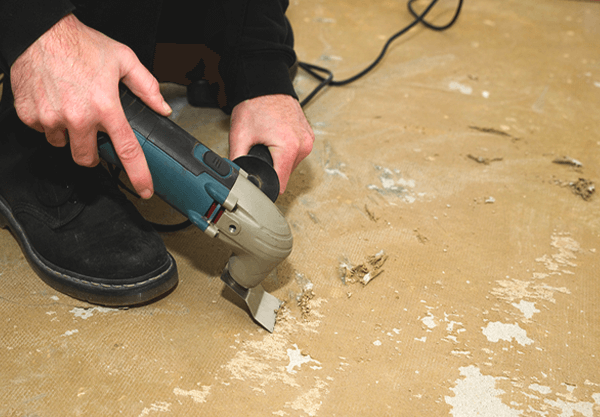One of the very traditional flooring methods includes using linoleum. If you’re wondering what linoleum is, it’s a mixture of linseed coil with cork. The back of the floor coverings has linoleum in it most of the time.
If you’ve newly bought a vintage house of your choice and stuck with linoleum flooring, it can be a tough situation to deal with.
You might think about spending thousands over removing the flooring. However, you can remove linoleum flooring if you follow the right steps. Whether or not your surface is wood or concrete, linoleum is easily removable.
You don’t have to panic when you come across sticky linoleum anymore. Hence, without any further ado, let’s start!

Contents
Why Should You Remove Linoleum From Your Floor?
You may think about this particular question a lot, “What’s the benefit of removing linoleum from the floor?” Well, to begin with, you might want to showcase the gorgeous wooden floor hidden under the linoleum floor covering like a secret gem. I mean, who doesn’t like the luxurious wooden feel underneath their feet?
However, even if you plan on sticking flooring, such as vinyl flooring, you must remove the linoleum on your house’s base. Linoleum was made in the early 1970s. During that time, the manufacturers mixed many harmful and weird chemicals into the adhesives.
The old adhesives will typically react with modern-day adhesives and make them weaker, and even cause discolorations over your new flooring.
In the long run, you’ll see your flooring buckling, moving out of place, and even becoming fragile and crumbly after a few days of using it.
Linoleum also has a toxic element added to it, which is named asbestos. It’s a cancer-causing silicate material. When you’re dealing with removing linoleum from wood floors, make sure it’s free of asbestos.
If you’re unsure of having an asbestos infestation, ensure that you moisten the area of linoleum removal while removing the flooring from the main wood base.
Most modern flooring comes with a warranty, but it does not cover damages caused by linoleum. Thus, it would help if you got rid of every bit of linoleum from the flooring of your house.
How to Remove Linoleum from Plywood
To remove one of the sturdiest adhesives ever, you’ll need to have a putty knife with you by your side while you remove the glue. Firstly, cut off the flooring into a measurement of your choice. If you want to moisten the area due to asbestos, make sure to do it when cutting the strips to ensure no asbestos flies around.
Start from the corner of your room. You can use your putty knife to get under the flooring and break the bonding of the adhesive. Now, you’ll see two separate layers – one for the flooring and one for the glue surface. The linoleum will come off easily with pulling, so remove the entire flooring first.
After the first layer is off, you can proceed to use a hammer and a putty knife to work your way into getting the glue off. If it’s stuck and not moving, don’t hammer too hard because it might damage the plywood floor.
We recommend getting a blow torch or hot-heat gun instead to heat your way into making the gum more relaxed and easy to pull. You can also try softening it by using mineral spirit, which works like a charm most of the time.
How to Remove Linoleum from Wood Floor
You can peel away the linoleum easily. The process is very similar to the one aforementioned.
Firstly, you’ll want to peel the flooring so that you can determine the intensity of the glue. It’s also important to determine which way you can feel the flooring direction is. Thus, make sure not to skip this step.
Cut the vinyl strips in any length which you’re comfortable working with. In this step, you’ll have to be extremely careful when you’re peeling off the linoleum. Any damage to the wood would be bad.
Especially since the wood is very absorbent, moisture will seep into the wood when you’re applying the new adhesive if you damage the wood layer.
We recommend you to certainly use a heat gun in this method. The heat gun will help to scrape away any of the glue that’ll remain on the floor. You’ll want to finish the process using a sanding method to level the wood with the flooring.
Should I place Vinyl Flooring On top Of the Linoleum?
Many people tend to go for this method. Why take the trouble of removing linoleum when you can easily put another layering of flooring above it?
However, the answer isn’t as easy as it seems. If you put vinyl flooring over damaged linoleum flooring, you can potentially damage the new flooring for eternity.
But, there’s one way you can line up new flooring over the previous linoleum flooring. You can smooth your floor, add a layer of FixAll, and make sure there’s no breakage point of your linoleum flooring. After it’s all set, you can place the new flooring on top of the previous linoleum.
You do have to remember that the process above isn’t applicable for vinyl flooring nor wood flooring. If you want to place vinyl or another flooring type, you’ll have to level a layer of concrete first. You can also choose to layer plywood over the pre-existing linoleum.
However, when you’re opting for this method, make sure you’re aware of how the room you’re going to do this in will be significantly taller than that of the other rooms’ floor. People unaware of this can easily trip over.
More On LivingProofMag
Can You Use a Steam Mop on Linoleum?
Best Linoleum Floor Cleaner Machine
Top 10 Mops for Vinyl Plank Flooring
Conclusion
Therefore, we hope you’ve learnt everything there is to learn about removing linoleum from wood floors. Make sure to be careful while you follow through each step carefully. In no time, your refurbished floor will look as good as new.
If you’re still concerned with your flooring and notice something unusual with it, you can have a professional take a look at it. Hence, till the next time, happy flooring!
